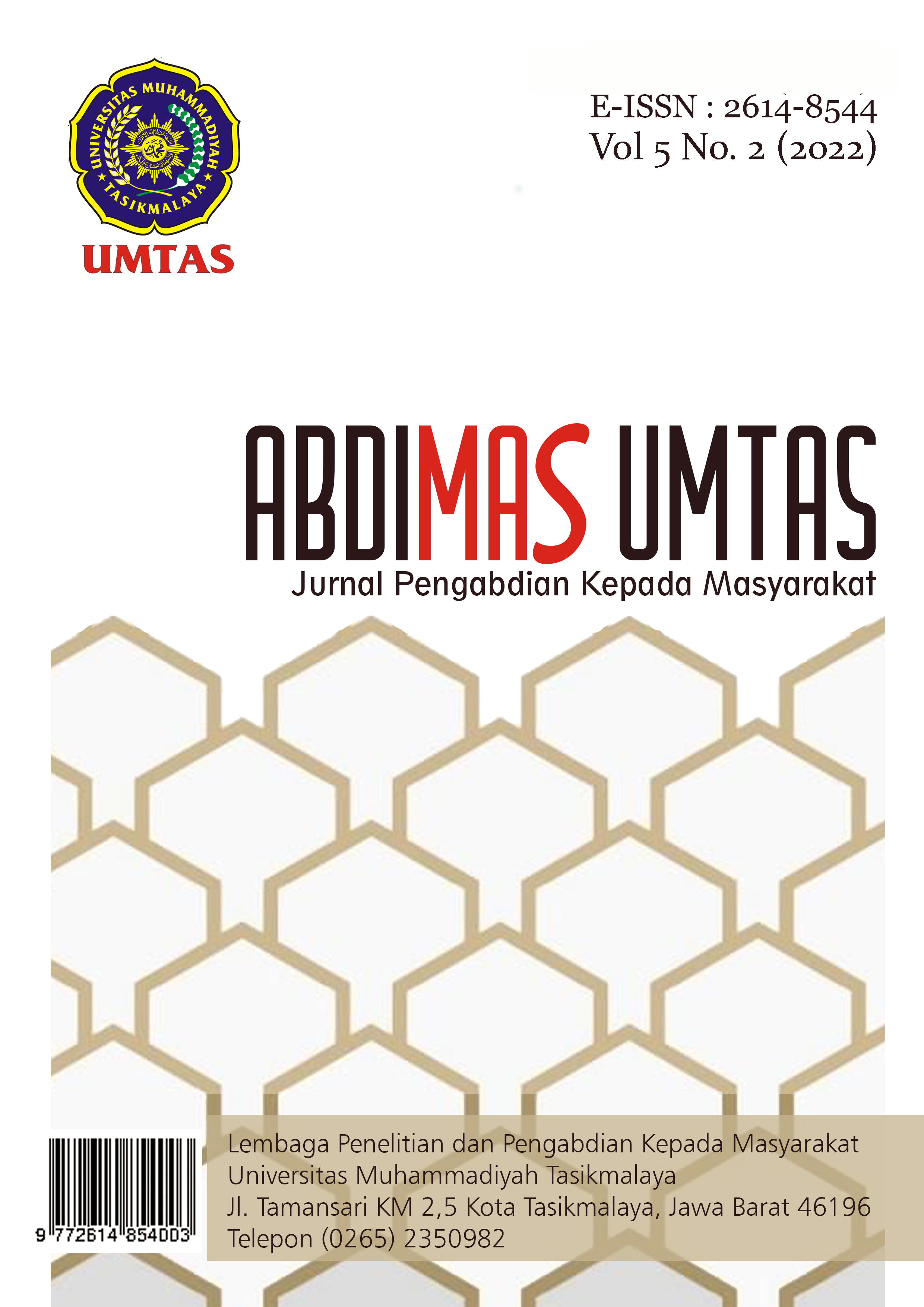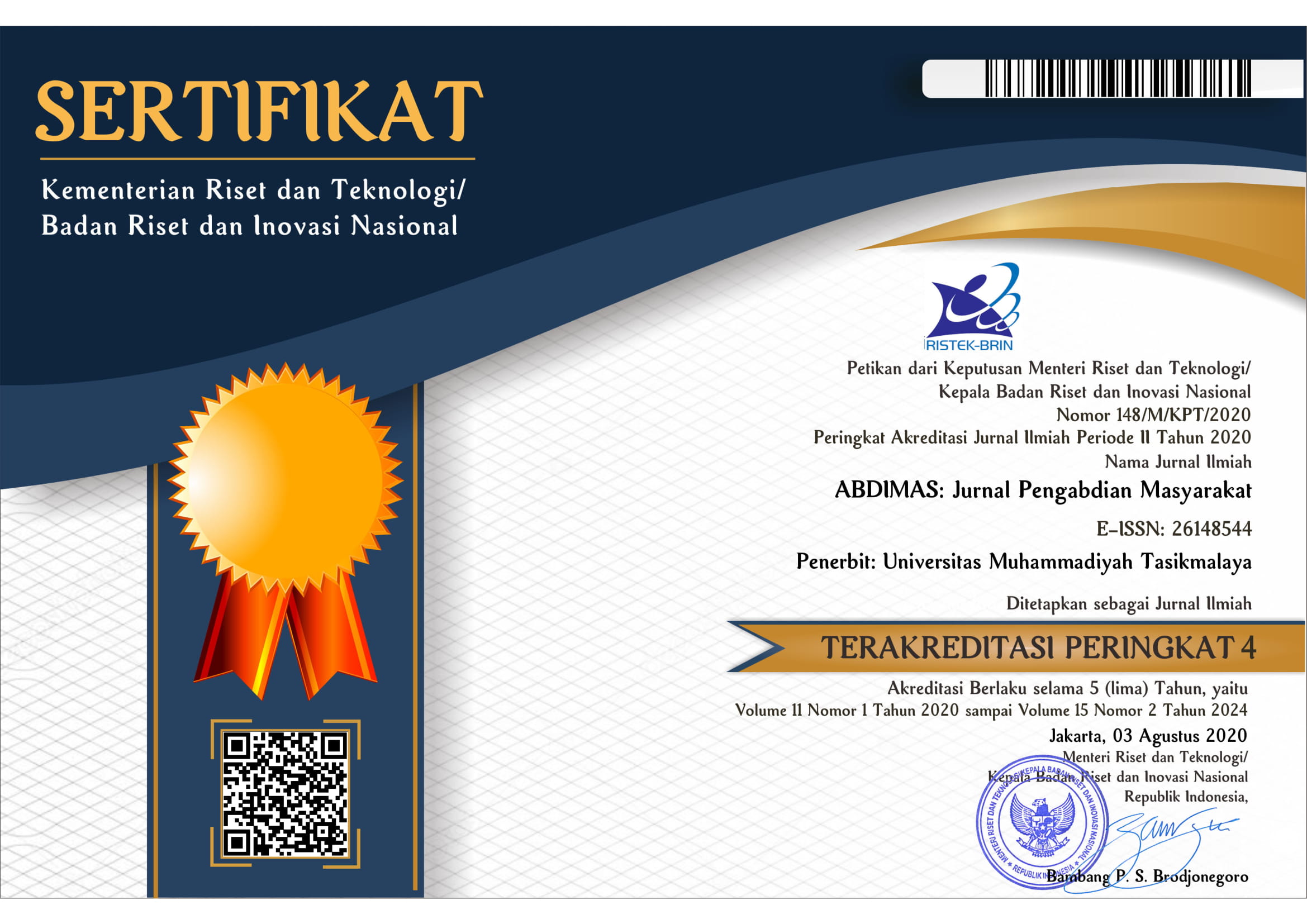Hydrotherapy Health Education to Reduce Blood Pressure in Hypertension
DOI:
https://doi.org/10.35568/abdimas.v5i2.2713Keywords:
Hypertension , Hydrotherapy , Blood pressureAbstract
The causes of hypertension in general are divided into two groups, namely primary and secondary. Primary hypertension is hypertension with no known cause such as heredity, age, gender, psychological pressure, stress, obesity (obesity), lack of exercise, and high cholesterol . While secondary hypertension is hypertension caused by other diseases such as narrowing of the arteries that supply blood to the kidneys, atherosclerosis (thickening of artery walls causing loss of elasticity of blood vessels). Foot soak hydrotherapy with warm water is one type of natural therapy that aims to increase blood circulation, reduce edema, increase muscle relaxation, nourish the heart, relax muscles, relieve stress, muscle aches, relieve pain, increase capillary permeability, provide warmth. on the body so that it is very useful for blood pressure reduction therapy in hypertension. This activity aims to increase people's knowledge about hydrotherapy health education on reducing blood pressure. The counseling method used leaflets and soaking the feet in warm water mixed with salt. After giving the material, participants know and understand the material that has been delivered by the speaker.
Keyword s: Hypertension , Hydrotherapy , Blood pressure
Downloads
References
Agung, SD (2015). The Effect of Warm Water Foot Soak Therapy Working Upk Equator Health Center Pontianak City Dwi Agung Santoso Nursing Study Program.
Alfeus, M. (2019). Cognitive Therapy in Hypertensive Patients. Wineka Media 2019. Amanda, D., & Martini, S. (2018). The Relationship between Demographic Characteristic and Central Obesity with Hypertension. Periodic Journal Epidemiology, 6 (1), 43. https://doi.org/10.20473/jbe.v6i12018.43-50
Arum, YTG (2019). Hypertension in the Productive Age Population (15-64 Years). HIGEIA (Journal of Public Health Research and Development), 3(3), 345–356.
Central Java Provincial Health Office. (2019). Central Java Province Health Profile In 2019. Central Java Provincial Health Office, 3511351(24), 273–275.
Efendi, H., & Larasati, T. (2017). Family Support in Disease Management Hypertension. Majority Journal, 6(1), 34–40.
Ermawati. (2020). Reference book: adherence to medication consumption of hypertension patients: measurement and ways to improve compliance. Granite Publisher.
Fildayanti, Tuti Dharmawati, LARP (2020). The Effect of Water Foot Soak with Warm Salt Mixed Water on Lowering Blood Pressure in Hypertensive Patients. Scientific Journal of Health Work, 1(1), 70–76. https://stikesks-kendari.e-journal.id/jikk
Hariawan, H., & Tatisina, CM (2020). Implementation of Family Empowerment and Hypertension Gymnastics as Self-Management Efforts for Hypertension Patients. Sasambo Community Service Journal, 1(2), 75. https://doi.org/10.32807/jpms.v1i2.478
Hasbullah, M, A., & DS, H. (2017). Journal of Nursing Media: Makassar Health Polytechnic Journal of Nursing Media: Makassar Health Polytechnic. The Effect of Soaking Feet Using Warm Water on Blood Pressure Reduction in Hypertension in the Work Area of the Pattallassang Community Health Center, Kab. Takalar, 08(02), 39–45.
Herdman T. Heather, SK (2018). Nanda International Diagnosis Nursing:Definitions and Classifications 2018-2020 (11th Edition) (EGC). Indah, PY (2014). Hypertension is not something to be afraid of. FMmedia. Indonesian Ministry of Health. (2019). Hypertension Leaflet. 1–10.
Komariyah, S. (2017). Qualitative Research Methodology. Bandung: Alphabeta.
Liszayanti. (2019). Effect of Foot Soak Therapy with Warm Water and Lemongrass on Blood Pressure of Pregnant Women with Pre-Eclampsia. Proceedings of the Faculty of Health Sciences, University of Muhammadiyah Semarang, 2, 299–309.
Meikha, BT (2015). The Effect of Warm Water Foot Soak on Blood Pressure Reduction in Elderly Patients with Hypertension in the Work Area of the Kebon Jeruk District Health Center, West Jakarta. Thesis of Esa Unggul University, West Jakarta.
Ngomane AY et al. “Hypotensive Effect of Heated Water-based Exercise in Older”. Int J Sports Med : Apr;40(4):283-291: (2019)
Nuraini, B. (2015). Risk factors of hypertension (Vol. 4).
Nurul, R., Putra, Y., & Amir, A. (2016). Research article on the relationship between body mass index (BMI) and age of menarche in SMP Negeri 1 Padang students. 5(3), 551–557.
PPNI. (2018). Indonesian Nursing Diagnosis Standards (IDHS). DPP PPNI. Prasetya, KS, & Chanif, C. (2020). Risk Management
Puji, HA (2020). Hypertension. Lekeisha.
Riskesdas, K. (2018). Main Results of Basic Health Research (RISKESDAS). Journal of Physics A: Mathematical and Theoretical, 44(8), 1–200. https://doi.or g/10.1088/1751-8113/44/8/085201
Sataloff, RT, Johns, MM, & Kost, KM (2018). HEALTH RESEARCH METHODOLOGY.
Suddarth, B. &. (2017). Medical-Surgical Nursing 12th Edition (EGC). Sumiyati. (2021). Anatomy Physiology. Our Writing Foundation.
Uliya, A. (2020). Foot Soak Therapy Using Warm Water With A Mixture Of Salt And Lemongrass To Lower Blood Pressure In Patients With Hypertension. 7(2), 88–102.
Wulandari, P., Arifianto, & Sekarningrum, D. (2016). The Effect of Foot Soak Using Warm Water with a Mixture of Salt and Lemongrass on Blood Pressure Reduction in Hypertension Patients in the Podorejo Region, RW 8 Ngaliyan. Nursing, 7 (2009), 43–47. http://ejournal.umm.ac.id/index.php/keperawatan/article/viewFile/3918/4397














